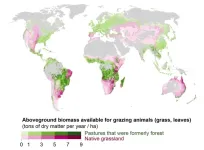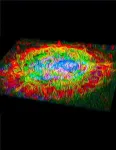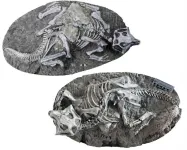(Press-News.org) American Geophysical Union
4 November 2024
AGU Release No. 24-35
For Immediate Release
This press release is available online at: https://news.agu.org/press-release/new-trigger-tonga-eruption/
New trigger proposed for record-smashing 2022 Tonga eruption
Previously unstudied data from a seismic wave, detected 750 kilometers from the seamount, may bolster tsunami early-warning systems.
AGU press contact:
Liza Lester, +1 (202) 777-7494, news@agu.org (UTC-5 hours)
Contact information for the researchers:
Mie Ichihara, University of Tokyo, ichihara@eri.u-tokyo.ac.jp, (UTC+9 hours)
WASHINGTON — Fifteen minutes before the massive January 2022 eruption of the Hunga Tonga-Hunga Ha’apai volcano, a seismic wave was recorded by two distant seismic stations. Now, researchers argue that similar early signals could be used to warn of other impending eruptions in remote oceanic volcanoes.
The researchers propose that the seismic wave was caused by a fracture in a weak area of oceanic crust beneath the volcano’s caldera wall. That fracture allowed seawater and magma to pour into and mix together in the space above the volcano’s subsurface magma chamber, explosively kickstarting the eruption.
The research was published in Geophysical Research Letters, an open-access AGU journal that publishes high-impact, short-format reports with immediate implications spanning all Earth and space sciences.
The results build on the researchers’ previous work monitoring remote volcanoes. In this case, the Rayleigh wave, a type of seismic wave that moves through the Earth’s surface, was detected 750 kilometers (approximately 466 miles) from the volcano.
“Early warnings are very important for disaster mitigation,” said Mie Ichihara, a volcanologist at the University of Tokyo and one of the study’s coauthors. “Island volcanoes can generate tsunamis, which are a significant hazard.”
Silent precursor to a violent eruption
Hunga Tonga-Hunga Ha’apai is an oceanic volcano in the western Pacific Ocean in the Kingdom of Tonga. The seamount was created by the subduction of the Pacific Plate underneath the Australian Plate, a process that generates magma and leads to eruptions.
On January 15, 2022, the volcano erupted with record-breaking energy, injecting 58,000 Olympic swimming pools of water vapor into the stratosphere, setting off an unprecedented lightning storm and generating a tsunami. That massive eruption was preceded by a smaller eruption on January 14 and, before that, a month of eruptive activity.
Researchers still debate the exact start time of the eruption, though most agree that the eruption started shortly after 4:00 Coordinated Universal Time (UTC). The new study reports a Rayleigh wave that started around 3:45 UTC.
The researchers used seismic data to analyze the Rayleigh wave, which was detected by instruments, but not felt by humans, at seismic stations on the islands of Fiji and Futuna. While Rayleigh waves are a common feature of volcanic eruptions and earthquakes, the researchers believe that this wave signified a precursor event and possible cause of the massive eruption.
“Many eruptions are preceded by seismic activity,” said Takuro Horiuchi, a volcanology graduate student at the University of Tokyo and the lead author of the study. “However, such seismic signals are subtle and only detected within several kilometers of the volcano.”
In contrast, this seismic signal traveled a great distance, indicating a huge seismic event. “We believe unusually large movements started at the time of the precursor,” Horiuchi said.
Secrets of the seamount
Scientists may never know exactly what caused the gigantic, “caldera-forming” eruption, but Ichihara believes that the process was not instantaneous. Instead, she thinks that this precursor event was the start of an underground process that ultimately led to the eruption.
But it can be difficult to nail down the origins of these rare, colossal eruptions.
“There are very few observed caldera-forming eruptions, and there are even fewer witnessed caldera-forming eruptions in the ocean,” Ichihara said. “This gives one scenario about the processes leading to caldera formation, but I wouldn’t say that this is the only scenario.”
Regardless, detecting early eruption signals may give island nations and coastal areas more valuable time to prepare when faced with imminent tsunamis — even when the signal cannot be felt on the surface.
“At the time of the eruption, we didn’t think of using this kind of analysis in real-time,” Ichihara said. “But maybe the next time that there is a significant eruption underwater, local observatories can recognize it from their data.”
Notes for Journalists:
This study is published in Geophysical Research Letters with open access. Neither the paper nor this press release is under embargo. View and download a pdf of the study.
Paper title:
“A seismic precursor 15 minutes before the giant eruption of Hunga Tonga-Hunga Ha’apai volcano on January 15, 2022”
Authors:
Takuro Horiuchi, University of Tokyo, Tokyo, Japan
Mie Ichihara, University of Tokyo, Tokyo, Japan
Kiwamu Nishida, University of Tokyo, Tokyo, Japan
Takayuki Kaneko, University of Tokyo, Tokyo, Japan
AGU (www.agu.org) is a global community supporting more than half a million advocates and professionals in Earth and space sciences. Through broad and inclusive partnerships, AGU aims to advance discovery and solution science that accelerate knowledge and create solutions that are ethical, unbiased and respectful of communities and their values. Our programs include serving as a scholarly publisher, convening virtual and in-person events and providing career support. We live our values in everything we do, such as our net zero energy renovated building in Washington, D.C. and our Ethics and Equity Center, which fosters a diverse and inclusive geoscience community to ensure responsible conduct.
END
New trigger proposed for record-smashing 2022 Tonga eruption
Previously unstudied data from a seismic wave, detected 750 kilometers from the seamount, may bolster tsunami early-warning systems.
2024-11-04
ELSE PRESS RELEASES FROM THIS DATE:
Lupus Research Alliance announces Lupus Research Highlights at ACR Convergence 2024
2024-11-04
Lupus Research Alliance Announces Lupus Research Highlights
at ACR Convergence 2024
Sixteen presentations of preclinical studies funded by the Lupus Research Alliance (LRA) to advance understanding of lupus and potential treatment pathways, including four oral presentations
Two reports by Lupus Therapeutics, the clinical affiliate of the LRA, and the Lupus Clinical Investigators Network (LuCIN) on promoting equity in lupus clinical trials, and identifying trial barriers and solutions
Fifteen industry-sponsored clinical research studies supported by Lupus Therapeutics and LuCIN, including positive results from the late-breaking Phase 3 dapirolizumab pegol trial ...
Satellite imagery may help protect coastal forests from climate change
2024-11-04
Sea-level rise caused by climate change poses a serious and often unpredictable threat to coastal forests, and new tools are needed to help mitigate damage and allocate conservation resources.
A new study from North Carolina State University and the United States Geological Survey (USGS) details how satellite imagery may help identify forested areas that are being transformed into marshes and open water by sea-level rise, a process known as regime change. Marcelo Ardón, associate professor at NC State and co-author of a paper on the study, ...
The secrets of baseball's magic mud
2024-11-04
EMBARGOED UNTIL MONDAY NOVEMBER 4 AT 3:00 P.M. ET
The unique properties of baseball’s famed “magic” mud have never been scientifically quantified — until now.
In a new paper in Proceedings of the National Academy of Sciences (PNAS), researchers at the University of Pennsylvania School of Engineering and Applied Science (Penn Engineering) and School of Arts & Sciences (SAS) reveal what makes the magic mud so special.
“It spreads like a skin cream and grips like sandpaper,” says Shravan Pradeep, the paper’s first author and a postdoctoral researcher in the labs of Douglas J. ...
Toddlers understand concept of possibility
2024-11-04
Children too young to know words like “impossible” and “improbable” nonetheless understand how possibility works, finds new work with two- and three-year-olds.
The findings, the first to demonstrate that young children distinguish between improbable and impossible events, and learn significantly better after impossible occurrences, is newly published in Proceedings of the National Academy of Sciences.
“Even young toddlers already think about the world in terms of possibilities,” said co-author Lisa Feigenson, co-director of the Johns Hopkins University Laboratory for Child Development. “Adults do this all the time and here we wanted ...
Small reductions to meat production in wealthier countries may help fight climate change, new analysis concludes
2024-11-04
Scientists and environmental activists have consistently called for drastic reductions in meat production as a way to reduce emissions and, in doing so, combat climate change. However, a new analysis concludes that a smaller reduction, borne by wealthier nations, could remove 125 billion tons of carbon dioxide—exceeding the total number of global fossil fuel emissions over the past three years—from the atmosphere.
Small cutbacks in higher-income countries—approximately 13% of total production—would reduce the amount of land needed for cattle grazing, the researchers note, allowing forests to naturally ...
Scientists determine why some patients don’t respond well to wet macular degeneration treatment, show how new experimental drug can bridge gap
2024-11-04
**EMBARGOED FOR RELEASE UNTIL NOV. 4 AT 3:00 P.M. EST**
A new study from researchers at Wilmer Eye Institute, Johns Hopkins Medicine explains not only why some patients with wet age-related macular degeneration (or “wet” AMD) fail to have vision improvement with treatment, but also how an experimental drug could be used with existing wet AMD treatments to save vision.
Wet AMD, one of two kinds of AMD, is a progressive eye condition caused by an overgrowth of blood vessels in the retina, the light-sensing tissue in ...
Did the world's best-preserved dinosaurs really die in 'Pompeii-type' events?
2024-11-04
Between about 120 million and 130 million years ago, during the age of dinosaurs, temperate forests and lakes hosted a lively ecosystem in what is now northeast China. Diverse fossils from that time remained pretty much undisturbed until the 1980s, when villagers started finding exceptionally preserved creatures, which fetched high prices from collectors and museums. This started a fossil gold rush. Both locals and scientists have now dug so much, their work can be seen from space―perhaps the most extensive paleontological excavations anywhere.
By the 1990s, it was clear that the so-called Yixian ...
Not the usual suspects: Novel genetic basis of pest resistance to biotech crops
2024-11-04
If left unchecked, insect pests can devastate crops. To minimize damage and reduce the need for insecticide sprays, crops have been genetically engineered to produce bacterial proteins that kill key pests but are not harmful to people or wildlife. However, widespread planting of such transgenic crops has led to rapid adaptation by some pests. A new study in the Proceedings of the National Academy of Sciences reveals a novel genetic basis of resistance to transgenic crops in one of the most important crop pests in the United States.
Researchers from the University of Arizona Department of Entomology in the College of Agriculture, Life and Environmental Sciences used genomics to investigate the ...
Jill Tarter to receive Inaugural Tarter Award for Innovation in the search for life beyond earth
2024-11-04
Jill Tarter to Receive Inaugural Tarter Award for Innovation in the Search for Life Beyond Earth
November 4, 2024, Mountain View, CA – Renowned astronomer, Dr. Jill Tarter, SETI Institute co-founder and pioneering SETI researcher, will be honored with the inaugural Tarter Award for Innovation in the Search for Life Beyond Earth at the SETI Institute’s 40th Anniversary celebration on November 20, 2024, in Menlo Park, CA. This new award recognizes individuals whose projects or ideas significantly advance humanity’s search for extraterrestrial life and intelligence. The Tarter Award honors contributions ...
Survey finds continued declines in HIV clinician workforce
2024-11-04
November 4, 2024 — The supply of healthcare professionals available to provide HIV care continues to decline, even as the need for HIV care and prevention is expected to increase, reports a survey study in the November/December issue of The Journal of the Association of Nurses in AIDS Care (JANAC). The official journal of the Association of Nurses in AIDS Care, JANAC is published in the Lippincott portfolio by Wolters Kluwer.
"Our study provides new insights into the numbers and characteristics of clinicians who will be available to provide HIV care in the coming years. This information ...
LAST 30 PRESS RELEASES:
UCLA study links scar healing to dangerous placenta condition
CHANGE-seq-BE finds off-target changes in the genome from base editors
The Journal of Nuclear Medicine Ahead-of-Print Tip Sheet: January 2, 2026
Delayed or absent first dose of measles, mumps, and rubella vaccination
Trends in US preterm birth rates by household income and race and ethnicity
Study identifies potential biomarker linked to progression and brain inflammation in multiple sclerosis
Many mothers in Norway do not show up for postnatal check-ups
Researchers want to find out why quick clay is so unstable
Superradiant spins show teamwork at the quantum scale
Cleveland Clinic Research links tumor bacteria to immunotherapy resistance in head and neck cancer
First Editorial of 2026: Resisting AI slop
Joint ground- and space-based observations reveal Saturn-mass rogue planet
Inheritable genetic variant offers protection against blood cancer risk and progression
Pigs settled Pacific islands alongside early human voyagers
A Coral reef’s daily pulse reshapes microbes in surrounding waters
EAST Tokamak experiments exceed plasma density limit, offering new approach to fusion ignition
Groundbreaking discovery reveals Africa’s oldest cremation pyre and complex ritual practices
First breathing ‘lung-on-chip’ developed using genetically identical cells
How people moved pigs across the Pacific
Interaction of climate change and human activity and its impact on plant diversity in Qinghai-Tibet plateau
From addressing uncertainty to national strategy: an interpretation of Professor Lim Siong Guan’s views
Clinical trials on AI language model use in digestive healthcare
Scientists improve robotic visual–inertial trajectory localization accuracy using cross-modal interaction and selection techniques
Correlation between cancer cachexia and immune-related adverse events in HCC
Human adipose tissue: a new source for functional organoids
Metro lines double as freight highways during off-peak hours, Beijing study shows
Biomedical functions and applications of nanomaterials in tumor diagnosis and treatment: perspectives from ophthalmic oncology
3D imaging unveils how passivation improves perovskite solar cell performance
Enriching framework Al sites in 8-membered rings of Cu-SSZ-39 zeolite to enhance low-temperature ammonia selective catalytic reduction performance
AI-powered RNA drug development: a new frontier in therapeutics
[Press-News.org] New trigger proposed for record-smashing 2022 Tonga eruptionPreviously unstudied data from a seismic wave, detected 750 kilometers from the seamount, may bolster tsunami early-warning systems.





